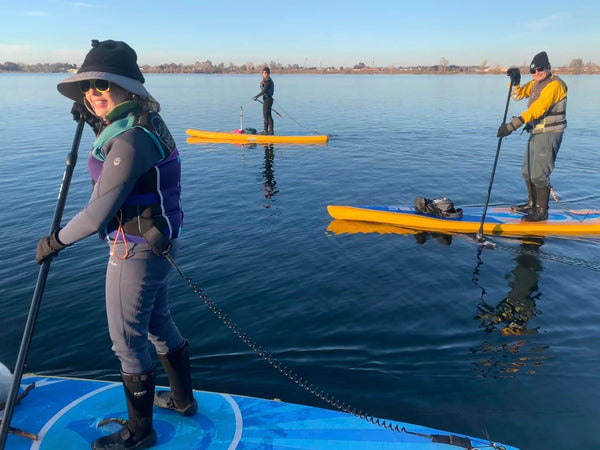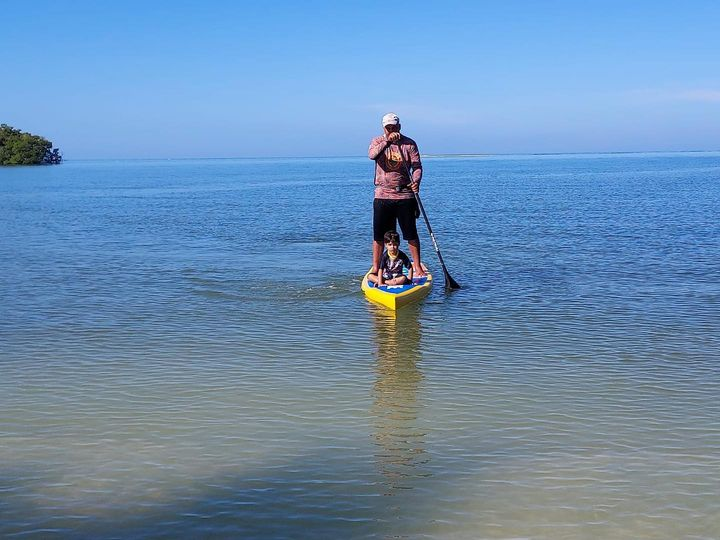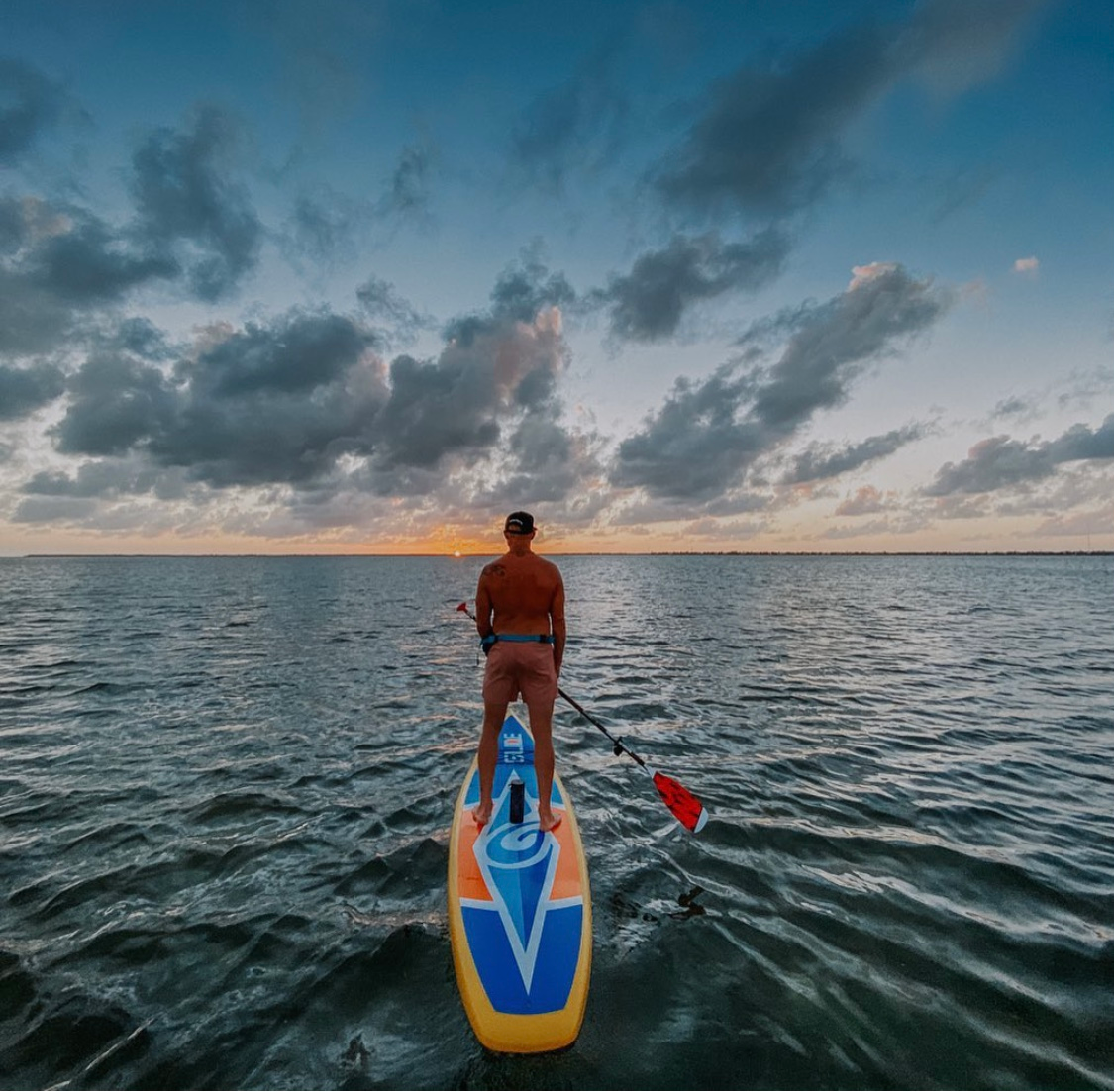
Training for the Long Haul: SUP Endurance Training
Build SUP endurance with the right board, smart pacing, intervals, core strength, and safety. A practical plan for longer, faster, safer miles—plus recovery, mindset, and cross-training to keep progress steady.
his endurance guide shows you how to paddle farther with less fatigue by sorting equipment first (inflatable vs. solid, length/width/thickness for stability and glide), then building stamina through progressive time and distance.
You’ll refine technique for efficient cruising pace, add intervals to raise speed–endurance, and strengthen your core and posterior chain off the water. Safety stays front-and-center with USCG PFDs, leashes, and weather checks.
Cross-training (dogs, SUP yoga) keeps sessions engaging while improving balance and flexibility.
Finally, you’ll lock in mental resilience for long efforts and prioritize recovery and nutrition so each week compounds.
The result: longer, smoother, safer miles.
Table of contents
Before you dive into any endurance training regimen, the most important thing to consider is your equipment. Picking the right stand-up paddle board (SUP) is crucial to your success and enjoyment on the water.

Inflatable vs. Solid Boards
There are two main types of paddle boards to choose from: inflatable and solid. Inflatable paddle boards are known for their portability and durability. They’re easy to transport and store, making them a convenient option. On the other hand, solid boards typically offer better speed and performance, which is something experienced paddlers might prefer.
For endurance training, the choice between an inflatable and a solid paddle board really depends on your personal preference, where you plan to paddle, and how you’ll store and transport your board. If you’ll be training in various conditions, an inflatable board might be more suitable because of its adaptability and ease of transportation. Interestingly, inflatable boards are becoming more popular and are expected to surpass solid boards in sales by 2030.
Paddle Board Dimensions
The size of your paddle board – its length, width, and thickness – significantly affects its performance. Longer boards are generally faster and better suited for lengthy, challenging paddles, while wider boards offer more stability, which is great for beginners or those looking to do SUP yoga.
For endurance training, you’ll want a board that’s stable, easy to handle, and capable of slicing through the water efficiently. Glide offers a variety of lightweight paddle boards that are ideal for long training sessions. Their boards are designed to be stable and comfortable, which is essential for spending extended periods on the water.
Endurance Training Techniques
Once you’ve chosen your perfect SUP, it’s time to focus on your training. Building stamina on a paddle board, like any endurance training, takes time, patience, and consistency. Start by gradually increasing the length of your paddling sessions. If you’re a beginner, you might start with 20- to 30-minute sessions, then add 5 to 10 minutes as your strength and stamina improve.
Endurance training isn’t about speed – it’s about distance. Keep a steady, consistent pace that allows you to paddle for longer periods without tiring quickly. Over time, you’ll find yourself able to maintain this pace for longer sessions, boosting your overall stamina and fitness.
Developing Core Strength

A key aspect of endurance training on a paddle board is developing core strength. Paddle boarding engages your core muscles for balance and movement, making it a fantastic full-body workout. To enhance your core strength, incorporate exercises that target these muscles into your training routine.
Paddle Longer Distances
Endurance training also involves gradually increasing the distances you paddle. This will help build your stamina and resilience. Remember to pace yourself to avoid overexertion or injury.
Interval Training
Interval training on a paddle board can be highly effective. This involves alternating between high-intensity paddling and periods of rest or low-intensity paddling. It’s a great way to improve both your speed and endurance over time.
Safety and Preparation
Life Jackets and Leashes
No matter your skill level, safety should always be a priority. Always wear a life jacket and use a leash attached to your board. Life jackets provide buoyancy if you fall into the water, and leashes keep your board from drifting away.
Weather and Water Conditions
Understanding and respecting weather and water conditions is vital when training for endurance SUP. Factors like wind direction, speed, water currents, and temperature can significantly affect your performance and safety.
Additional Training Tips
Paddle boards are not just for endurance training – they’re also great for cross-training activities.
Paddle Boarding with Dogs
Bringing your dog along for a paddle can be a fantastic bonding experience and a fun way to diversify your training. Make sure to introduce your dog to the board gradually, ensure their safety, and make the experience enjoyable for both of you.
SUP Yoga
SUP yoga combines the calming practice of yoga with the challenge of maintaining balance on a paddle board. It can enhance your core strength, flexibility, and balance, all of which are crucial for endurance training.
Mental Strength and Endurance Training
Endurance training isn’t just about physical stamina; it also requires mental resilience. Paddling for extended periods can be mentally challenging. Developing a strong mindset is a crucial part of your training. Focusing on the rhythmic movement of paddling and the soothing sounds of the water can be a form of moving meditation, helping you build mental endurance along with physical stamina.
Recovery and Nutrition
Finally, don’t forget the importance of recovery and nutrition. No matter how rigorous your training, your body needs time to rest and recover for muscle repair and growth. A balanced diet that fuels your body with the necessary nutrients is equally important.
- Gear first: choose a stable, efficient touring setup you can train on consistently (12’6–14’ board, medium touring fin, light paddle).
- Build base: add ~10% time/distance weekly at easy, conversational pace; keep cadence smooth and strokes short/clean.
- Add intervals 1–2×/week: e.g., 6×3 min hard / 2 min easy to raise sustainable speed without overtraining.
- Strength & core: 2–3 sessions/week (anti-rotation core, hip hinge, rows/pulls) plus 2–3 cardio sessions for aerobic capacity.
- Safety & recovery: USCG PFD + correct leash, check weather/tides, hydrate/electrolytes, fuel long paddles, and sleep 7–9 hours.
Key Takeaways: SUP Endurance Training
SUP Endurance training can be a rewarding experience that combines fitness, adventure, and the tranquility of being out on the water. As you prepare for this challenge, remember the importance of choosing the right equipment, training progressively, and prioritizing safety. With dedication, consistency, and a love for the sport, you’ll see your endurance grow over time.
(Note: Be sure to consult a healthcare provider before starting any new fitness regimen. This guide is intended for general informational purposes only and should not be used as a substitute for professional advice.)
SUP Endurance Training: Quick Checklist
- Gear first: choose a stable, efficient touring setup you can train on consistently (12’6–14’ board, medium touring fin, light paddle).
- Build base: add ~10% time/distance weekly at easy, conversational pace; keep cadence smooth and strokes short/clean.
- Add intervals 1–2×/week: e.g., 6×3 min hard / 2 min easy to raise sustainable speed without overtraining.
- Strength & core: 2–3 sessions/week (anti-rotation core, hip hinge, rows/pulls) plus 2–3 cardio sessions for aerobic capacity.
-
Safety & recovery: USCG PFD + correct leash, check weather/tides, hydrate/electrolytes, fuel long paddles, and sleep 7–9 hours.
Conclusion: SUP Endurance Training

FAQs
Is an inflatable or hard board better for endurance?
Hard boards are typically faster; inflatables win on portability and stability. Choose the one you can train on consistently.
What board size works best for distance?
Longer (12’6–14’) and moderately narrow touring shapes balance glide and stability. Pick the narrowest you can comfortably stand on for an hour.
How should I progress time and distance?
Add 5–10 minutes or ~10% per week to your longest session. Hold easy, conversational pace on most miles.
Do I need intervals for endurance?
es—1–2 sessions weekly (e.g., 6×3 min hard / 2 min easy) improve speed–endurance and raise your sustainable pace.
What off-water training helps most?
Core (anti-rotation), hip hinge, rows/pulls, and aerobic base (running/cycling/swimming). Aim 2–3 strength + 2–3 cardio sessions weekly.
How do I fuel and recover?
Hydrate, add electrolytes for >60 min sessions, take carbs during long paddles, and eat protein + carbs within 60 minutes post-paddle. Sleep 7–9 hours.
What cadence should I aim for on long paddles?
Comfortable steady state (often 35–45 SPM). Maintain clean catch and early exit; increase cadence slightly in headwinds or chop.
How do weather and water affect endurance days?
Plan routes with wind/current in mind (hard out, easy back). Check NOAA forecasts, temps, and daylight; adjust leash/PFD and clothing.
Which fin setup is best for distance?
A medium, raked touring fin set slightly aft often gives the best tracking with manageable drag. Test what holds your line at endurance cadence.
Can I bring my dog on endurance sessions?
Yes—start with short calm-water sessions, use a stable board, add a dog PFD, and build distance gradually.





